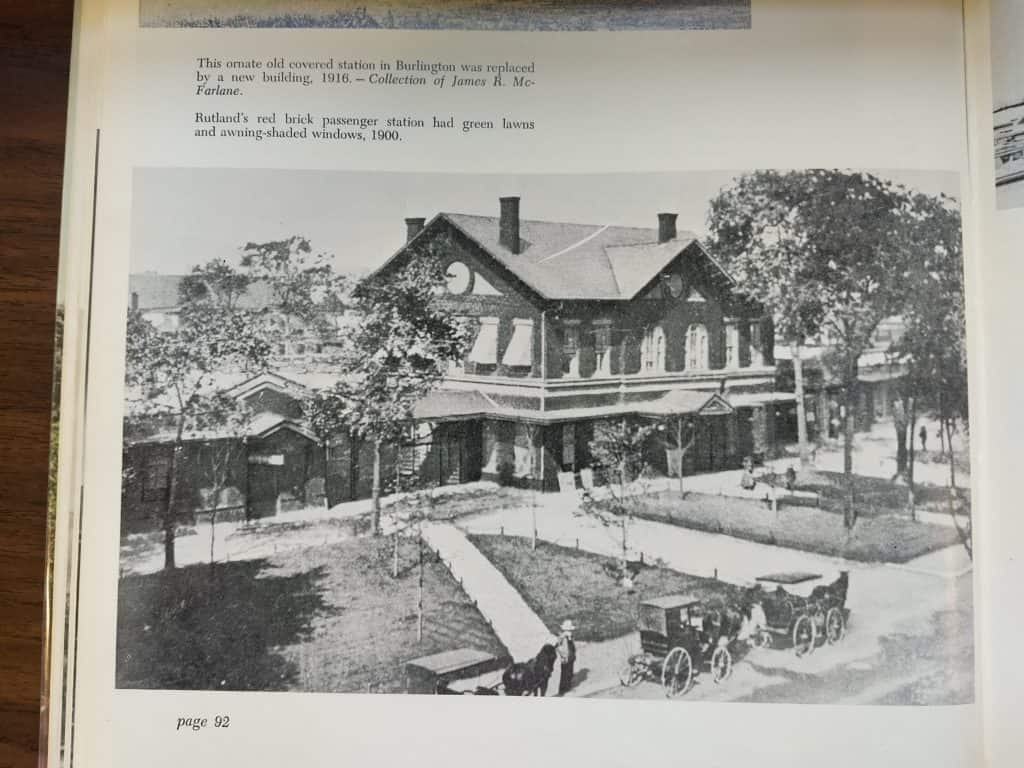
By Julia Purdy
A proposal to expand Depot Park and create an Amtrak “gateway” to make downtown Rutland more welcoming is sure to strike a note of nostalgia among old-time Rutlanders for the large passenger depot that graced the site now occupied by the downtown plaza parking lot.
The old Rutland passenger depot appears in historic photos as having an imposing two-story, 6-bay façade featuring arched windows and bracketed eaves. Trains entered through archways on the south side into a train shed that contained the platform. Deep overhangs sheltered outside seating.
The then-Rutland Railroad was headquartered in Rutland, and beginning in the 1850s, the city became the hub of southern Vermont’s sprawling rail network. The depot spurred the rise of a new commercial district of fashionable shops, offices, hotels, barbershops and restaurants, christened Merchants’ Row.
While the recently released Reimagine Rutland Downtown Strategic Plan can not bring the glory days of the railroad back to Rutland, it does aim to capitalize on the small, retro-style Amtrak station, which opened in 1999 on a slice of city property beside the railroad tracks.
The north end of the plaza in front of the Amtrak station, now a dilapidated overflow parking area with one barred-off space used for snow storage in winter, is envisioned as the “Amtrak Station Gateway.”
As the original passenger depot did 168 years ago, this project would help to upgrade Rutland’s public spaces and highlight the striking architectural styles of the buildings that catch the late afternoon sun along Merchants Row.
Rutland native Carol Clifford shared a few memories of the old depot. Clifford’s grandfather, Luke Alfred Hudson, was an engineer driving locomotives for the Rutland Railroad, as was her great-uncle, Kit David Hudson. In the 1940s she was just a “little kid not even in kindergarten,” she told the Mountain Times. She remembers the station as “echoey inside, your footsteps echoed as you crossed the floor. There were these big wagons that they put the luggage on … It was very dirty because of the coal.”
Clifford also remembers “a beautiful park in front, lots of trees and green space.”
Small depots and whistle stops dotted the various lines and area people took the train from surrounding towns to shop or attend school and events, especially during the Second World War when rationing of gasoline and tires limited travel by car. The Hudson family enjoyed the wartime luxury of real butter “because my grandfather brought it down from Canada. It wasn’t rationed up there,” she said.
Mary Ellen Chase of Rutland recalled her mother telling her that she used to take the train from her home in Wallingford to Rutland to attend Rutland Business College in the ‘20s.
Clifford remembers getting a train pass and riding the train “anywhere we wanted to go,” even as far afield as Albany. “I went to a lot of different places on the train,” she said.
In addition to passenger and freight service, there were the milk train, the marble train and the mail train. Even 100 years later, “a hundred trains came through here every day,” Clifford recalled.
The final report of the plan, released May 2020, notes the scarcity of attractive spaces for people to play or rest downtown as well as the need for better-defined “gateways” to downtown, to counter visitors’ negative impressions of Rutland and reflect Rutland’s own “poor self-image.” It is another incremental step toward the goal of restoring downtown — for businesses, residents and visitors — by making it a more welcoming place.
The report calls for the beautification of Evelyn Street and a “gateway” kiosk on the corner of West Street, which would usher the public toward a new, improved Depot Park that might include a dog park, playground, public event space, painted bike lanes, a public art feature, and a bike-share station.
The “gateway area” at the Amtrak Depot is a high-priority project, attuned to other priority goals including public art installations and the development of downtown outdoor recreation and dining. The time frame for completion is estimated at two to four years. Cost and staff investments are anticipated to be low, a collaboration of the city, the Rutland Redevelopment Authority (RRA) and the Downtown Rutland Partnership (DRP).
The current report follows an earlier strategic plan put forth in 2009 and revised in 2013 for the downtown business district.
“These are ideas that are options,” Steve Peters, DRP Executive Director, explained to the Mountain Times.
Revisioning is done as the need arises to meet changes in the public’s behaviors, today’s conditions, today’s world, he continued. Peter Farrow’s 1984 sculpture of the dog straining at an imaginary leash was an early gesture in that direction. Some of the 2009 goals were carried out, Peters said, including the downtown Castleton dorms and finding a permanent home for the Farmers’ Market.
“Things don’t change overnight … there’s no magic wand. We have to do the pieces that make sense, that we can get people on board with, get funding for.” Noting the Covid-19 restrictions, “We have to do one thing at a time,” he added.




